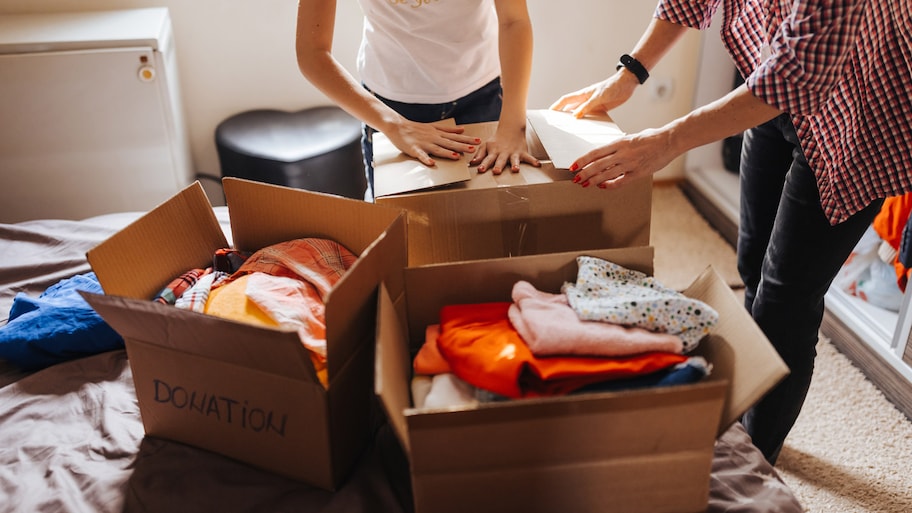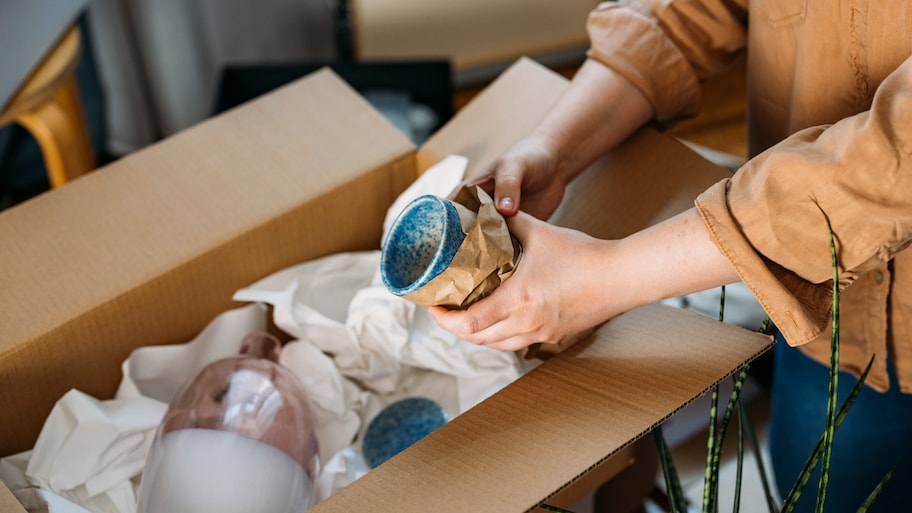How to Pack for a Move: Best Checklist for Your Move
Simplify the packing process for each room in your home


Don’t let the monumental job of packing your home for a move overwhelm you. Like many daunting DIY projects, learning how to pack for a move is more manageable when you divide it down into steps (snack breaks included). Our checklist is here to help: Let’s review how to pack for a move room-by-room for a smoother moving day.
How to Prepare to Start Packing For a Move
The earlier you start preparing for a move, the better! In fact, many preparation steps can be finished several months before moving day. Take the time to prepare with these essential steps:
Budget for your move: Creating a moving budget will set spending expectations early, especially when accounting for packing supplies, moving truck rentals, and hiring professional movers.
Declutter your home: This step alone can take a whole week, so give yourself plenty of time. Remove items that you no longer need or use, and consider a trip to a local disposal facility after you’ve filled a few trash bags, or even renting a personal dumpster.
Donate or sell lightly used items: For lighter clean-up, holding a garage sale or donating items is an excellent way to declutter. Remember to go through closets, attics, garage storage, and more to eliminate everything you don’t need in your new home.
Start collecting moving boxes: Take a preliminary look through your belongings and estimate how many moving boxes you’ll need. Start gathering boxes for your move. You can find many for free from local stores or offices, or you can purchase them at office supply stores, grocery stores, and other spots.
Buy packing materials: While old towels and wadded newspaper can help, most moves will require standard packing materials like foam, bubble wrap, packing peanuts, packing tape, box labels, and more. Now is the time to purchase specialized packing items, like wardrobe boxes, plastic wrap for furniture, TV boxes, and lamp boxes.
Make an inventory list: To keep track of your belongings, create a detailed inventory list of each essential item and which box it’s in. That way, you can ensure all items are accounted for and easy to find in your new home.
Hire professional movers: Moving is no small feat, especially if you’re moving a large house with several heavy items. Consider hiring local movers to ensure your move runs smoothly, safely, and efficiently.
Garage and Other Storage Areas
Most of these tips apply not only to your garage, but to other storage areas like the attic, basement, and storage shed.
Get rid of half-empty cans, bottles, and bags. Be sure to remove potentially hazardous items, like weed killers.
Pack cushions and decorations into storage bins or moving boxes, labeling them accordingly.
Wrap your tools. Take special care of saws, knives, and hammers.
Store and box tools with careful labels. Keep out a set of basic tools along with your essentials to help when moving into your new home.
Drain fuel from your outdoor appliances, like lawn mowers, ahead of a move.
For large items like surfboards and bikes, stick labels on them indicating they’re destined for a storage unit or should be mounted on your car when move day comes.
Disassemble storage racks or shelves and bind them with plastic wrap.
Bedrooms

Follow these guidelines for packing up bedrooms in your home.
To pack your clothing, fold your casual clothing, starting with least-used clothing, and pack it lightly into boxes. For formal wear, use wardrobe boxes for protection.
Pack up shoes, belts, and other items in a moving box labeled “accessories.”
Important jewelry should be part of your essential moving-day kit. Pack other jewelry away in a secure container.
Mattresses can get very dirty when moving, so protect them by packing them in a mattress bag.
Pack sheets, pillowcases, and other bedding in a moving box. Separate the bedding you plan to use upon moving into your new home so it’s easy to find during unpacking.
Pack bedroom rugs for moving by rolling it tight, tying it with rope or string, wrapping it in kraft paper, and storing it horizontally during moving.
De-assemble bedroom furniture, such as dressers and nightstands, before packing. Be sure to empty all drawers and pack them separately to making moving furniture easier.
Bathrooms
Bathrooms are easy to pack as long as you remember to set aside essentials and clean thoroughly afterward.
Declutter bathroom products, toiletries, and medicines before packing. Donate unused items and throw away used items you no longer need or use.
Organize your non-essential toiletries into plastic bags for safety and to avoid messes. Pack them together in boxes.
Pack towels, shower curtains, and toilet paper in boxes. You may want to save older towels for packing padding.
Consider disposing of bathroom cleaning supplies, like toilet plungers, and starting fresh with a new set in your new home.
Pack your moving day essentials separately, including toothbrush, toothpaste, skin care, and other daily toiletries.
Kitchen

Kitchens take extra work to pack up due to the number and size of items. Don’t be afraid to start early and go slowly as the moving day draws near.
Pack dishes for moving using layers of packing paper, then pack in boxes. Stack plates vertically and be sure to use extra padding for protection.
Pack jars, pots, and pans the same way as dishes.
Declutter your pantry before packing. Throw away opened bags or containers and donate unopened food items.
If possible, purchase sectioned boxes for glassware like wine glasses and cups. These are perfect for moving. Otherwise, consider double-boxing these items for extra protection.
Tape up small appliances and their accessories, then pack carefully with padding.
Two to three days before your move day, get rid of all unnecessary items in your fridge and freezer. Defrost them both, and clean them thoroughly.
If you plan to move your refrigerator, let it come to room temperature for one day before moving.
Dining Room
Dining rooms require several important steps to pack up correctly.
If you have a large rug in your dining room, roll it up and secure it well with kraft paper and ties.
Many dining chairs have removable legs. Unscrew legs if possible, and pack them with chair tops and plastic wrap.
Line your table with blankets and secure with plastic wrap. Test on a hard surface to make sure it can’t slip around easily.
Store any pads, casters, or screws in a separate bag for later use.
Pack pictures and artwork by wrapping the frame in packing paper and using appropriately-sized frame boxes to keep them safe.
Living Room
Living rooms are home to plenty of furniture and electronics. Make sure you have lots of space to work in when packing:
Unplug and organize your electronics. Securely tape (and label, if necessary) all cables and wires to their corresponding electronics. Wrap them with padding materials and pack them in boxes.
Inspect your furniture and disassemble into as many small pieces as possible. When possible, unscrew furniture legs and pack them separately for easier transport.
Wrap furniture with plastic wrap and padding.
Use a TV box to protect your TV and consider packing with a TV cover, corner protectors, bubble wrap, and plastic wrap.
Unscrew lamp light bulbs and lampshades. Pack these in boxes with padding.
Artwork and décor require careful treatment. Provide them with extra padding in the moving boxes.
Den or Library

Most of the living room steps apply to dens and studies, but there are a few things to pack specifically.
As with bathroom toiletries, use plastic bags or small storage containers to divide and store desk supplies and electronics accessories.
Avoid packing books over 30 pounds per box. Divide them up among smaller boxes if possible, and use packing paper or bubble wrap to pad corners.
Wrap file cabinets and bookshelves with padding at the corners, followed by plastic wrap. Tape all drawers to keep them secure during moving.
Pack all files in a secure box and label well. If you have particularly important files, move them to a safe or keep them in your moving-day essentials box.
Laundry Room
Keep these laundry room packing tips in mind:
Use any spare towels or clothes as packing materials for delicate items. There’s a small risk of damage to padding, so spare your most valuable towels and pack separately.
Use your hampers as storage crates to store spare goods and make transport easier.
Wash and dry bedding and essential clothing several days ahead of a move.
Pack leftover detergent, fabric softeners, and other laundry liquids. Be sure to seal tightly and pack separately from other items to avoid spilling during transport.
Save cleaning supplies for last if you want to clean after you pack. Then, add them to one of the final moving boxes.
Disconnect the washer and dryer if you don’t plan on taking them with you.
Pack your washer and dryer for moving by disconnecting and cleaning devices, carefully tape cables and ducts onto the appliances for transport, and leave it for the professional movers to handle.
